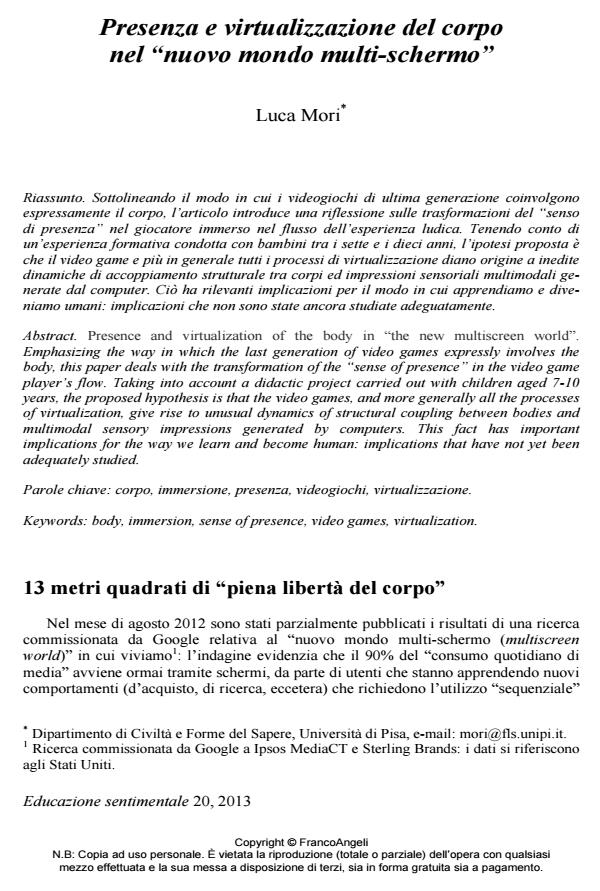Presenza e virtualizzazione del corpo nel "nuovo mondo multi-schermo"
Titolo Rivista EDUCAZIONE SENTIMENTALE
Autori/Curatori Luca Mori
Anno di pubblicazione 2013 Fascicolo 2013/20 Lingua Italiano
Numero pagine 14 P. 53-66 Dimensione file 669 KB
DOI 10.3280/EDS2013-020006
Il DOI è il codice a barre della proprietà intellettuale: per saperne di più
clicca qui
Qui sotto puoi vedere in anteprima la prima pagina di questo articolo.
Se questo articolo ti interessa, lo puoi acquistare (e scaricare in formato pdf) seguendo le facili indicazioni per acquistare il download credit. Acquista Download Credits per scaricare questo Articolo in formato PDF

FrancoAngeli è membro della Publishers International Linking Association, Inc (PILA)associazione indipendente e non profit per facilitare (attraverso i servizi tecnologici implementati da CrossRef.org) l’accesso degli studiosi ai contenuti digitali nelle pubblicazioni professionali e scientifiche
Sottolineando il modo in cui i videogiochi di ultima generazione coinvolgono espressamente il corpo, l’articolo introduce una riflessione sulle trasformazioni del "senso di presenza" nel giocatore immerso nel flusso dell’esperienza ludica. Tenendo conto di un’esperienza formativa condotta con bambini tra i sette e i dieci anni, l’ipotesi proposta è che il video game e più in generale tutti i processi di virtualizzazione diano origine a inedite dinamiche di accoppiamento strutturale tra corpi ed impressioni sensoriali multimodali generate dal computer. Ciò ha rilevanti implicazioni per il modo in cui apprendiamo e diveniamo umani: implicazioni che non sono state ancora studiate adeguatamente.;
Keywords:Corpo, immersione, presenza, videogiochi, virtualizzazione.
- Cardullo F.M. (1991). An assessment of the importance of motion cuing based on the relationship between simulated aircrafts dynamics and pilot performance: A review of the literature. AIAA Flight Simulation Technologies Conference, New York: American Institute of Aeronautics and Astronautics, pp. 436-447.
- de Martino E. (1948; 2000). Il mondo magico. Prolegomeni a una storia del magismo. Torino: Bollati Boringhieri.
- Gopher D. (2011). Skill training in multimodal virtual environment. In: Bergamasco M., Bardy B., Carrillo A.R. e Gutiérrez T., editors, Skill Learning and Virtual Environments. Pisa: Mnemosyne, pp. 8-15.
- Jennett C., Cox A.L., Cairns P., Dhoparee S., Epps A., Tijs T. e Walton A. (2008). Measuring and Defining the Experience of Immersion in Games. International Journal of Human-Computer Studies, 66, 9: 641-661, DOI: 10.1016/j.ijhcs.2008.04.004
- Kaiser M.K. e Schroeder J.A. (2003). Flights of fancy: the art and science of flight simulation. In: Tsang P. M. e Vidulich M. A., editors, Principles and practice of aviation psychology. Mahwah: Lawrence Erlbaum.
- Min Lee K. e Peng W. (2006). What Do We Know About Social and Psychological Effects of Computer Games? A Comprehensive Review of the Current Literature. In: Vorderer, P. e Bryant J., editors, Playing Video Games. Motives, Responses, and Consequences, Mahwah: Lawrence Erlbaum Associates, pp. 383-407.
- Nozick R. (1974). Anarchy, State, and Utopia. Oxford: Basil Blackwell. Trad. it. Anarchia, stato e utopia. Milano: Il Saggiatore, 2008.
- Olson C.K. (2010). Children’s Motivations for Video Game Play in the Context of Normal Development. Review of General Psychology, 14, 2: 180-187, DOI: 10.1037/a0018984
- Plantiga C. (2009). Moving Viewers: American Film and the Spectator’s Experience. Berkeley: University of California Press.
- Plessner H. (1970). Anthropologie der Sinne, in Id., Gesammelte Schriften, Bd. III. Frankfurt a. M.: Suhrkamp, 1980-1985.
- Przybylski A.K., Weinstein N., Murayama K., Lynch M.F. e Ryan R.M. (2012). The Ideal Self at Play: The Appeal of Video Games That Let You Be All You Can Be. Psychological Science, 23, 1: 69-76, DOI: 10.1177/0956797611418676
- Rigby S. e Ryan R.M. (2011). Glued to Games: How Video Games Draw Us in and Hold Us Spellbound. Santa Barbara: Praeger.
- Ruffaldi E., Filippeschi A., Avizzano C.A., Bardi B., Gopher D. e Bergamasco M. (2011). Feedback, Affordances, and Accelerators for Training Sports in Virtual Environments. Presence, 20, 1: 33-46, DOI: 10.1162/pres_a_00034
- Russo A., a cura di (1978). Scettici antichi. Torino: UTET.
- Russo M. (2007). Al confine. Escursioni sulla condizione umana. Milano: Mimesis.
- Ryan R.M., Rigby C.S. e Przybylski A.K. (2006). The motivational pull of videogames: A self-determination theory approach. Motivation and Emotion, 30: 347-364, DOI: 10.1007/s11031-006-9051-8
- Sanchez-Vives M.V. e Slater M. (2005). From Presence to Consciousness through virtual reality. Nature Reviews, 6: 332-339, DOI: 10.1038/nrn1651
- Stendhal (1822). Racine et Shakespeare. Trad. it.: Racine e Shakespeare (1822) e altri scritti sull’illusione, a cura di Luca Mori. Pisa: ETS.
- Stern D.N. (1985; 2006) The Interpersonal World of the Infant. A View from Psychoanalysis and developmental Psychology. London: Karnac. Trad. it.: Il mondo interpersonale del bambino. Torino: Bollati Boringhieri, 1987.
- Turkle, S. (2012). Alone Together: Why We Expect More from Technology and Less from Each Other. New York: Basic Books, 2011. Trad. it.: Insieme ma soli. Perché ci aspettiamo sempre più dalla tecnologia e sempre meno dagli altri. Torino: Codice Edizioni.
- von Salisch M., Oppl C. e Kristen A. (2006). What Attracts Children?. In: Vorderer P. e Bryant J., editors, Playing Video Games. Motives, Responses, and Consequences. Mahwah: Lawrence Erlbaum Associates, pp. 170-190.
- Weller J.M. (2004). Simulation in undergraduate medical education: bridging the gap between theory and practice. Medical Education, 30: 32-38, DOI: 10.1111/j.1365-2923.2004.01739.x
- Winnicott D.W. (1971). Playing and reality. Tavistock Publications: London. Trad. it.: Gioco e realtà. Roma: Armando, 1974.
Luca Mori, Presenza e virtualizzazione del corpo nel "nuovo mondo multi-schermo" in "EDUCAZIONE SENTIMENTALE" 20/2013, pp 53-66, DOI: 10.3280/EDS2013-020006